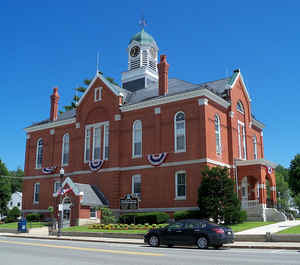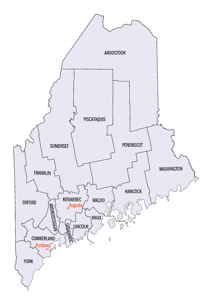Maine Counties
There are sixteen Counties in Maine. Prior to statehood. The first county to be created was York County, created as York County, Massachusetts by the government of the Massachusetts Bay Colony in 1652. Maine was granted statehood on March 15, 1820 as part of the Missouri Compromise. Nine of the sixteen Counties had their borders defined while Maine was still part of Massachusetts, and hence are older than the state itself. Even after 1820, the exact location of the northern border of Maine was disputed with Britain, until the question was settled and the northern counties took their final, official form by treaty in 1845.Franklin County, Maine
Franklin County Education, Geography, and History
Franklin County is a county located in the state of Maine. Based on the 2010 census, the population was 30,768, making it the second-least populous county in Maine. Its county seat is Farmington. The county was established on 9 May 1838 and named for Benjamin Franklin.
Etymology - Origin of Franklin County Name
Franklin is named for Benjamin Franklin, the Founding Father, scientist, printer, and diplomat.
Demographics:
County QuickFacts: CensusBureau Quick Facts
Franklin County History
History of Franklin County, Maine
From: A Gazetteer of the State of Maine
By Geo. J. Varney
Published by B. B. Russell, 57 Cornhill,
Boston 1886
Franklin County is situated in the western part of the State, its northern extremity bordering on Canada.
Somerset County bounds it on the east, Kennebec and Androscoggin on the south, and Oxford County on the west. The
area is 1,600 square miles. The Saddleback and Mount Abraham range of mountains, continuing eastward on a line with
the Rangeley Lakes, divides the county in two nearly equal portions and separates the Sandy River valley on the
south from that of Dead River on the north. From the line of highlands that marks the boundary between it and Canada
flow down the head waters of the Androscoggin and Kennebec. Mount Abraham, 3,387 feet in height, and Saddleback
Mountain, about 4,000 feet, mark the middle portion of the county, and Blue Mountain, also about 4,000 in height,
with its eastward range of hills, subdivides the southern section. The Androseoggin River passes across a corner of
Jay, the south-western town of the county, and the streams of towns on this side are generally tributary to this
river. An interesting feature is the combiriation of scenery, about one little valley of ten miles radius from the
town of Farmington, embracing the bold features of mountain ranges, with the low, warm, fertile valley, having the
geological features and botanical exuberance which are not often found except in extensive countries. The region in
view from the Saddleback range is no less striking, for on the west and south-west lie the Rangelev and Richardson
Lakes, partly in Franklin and partly in Oxford; northward is the Dead River Valley with this tributary of the
Kennebec winding peacefully through it. Clearings in many directions sliowdots of buildings and broad tracts of
grass-land and cultivated field.
Franklin County was the home of the Norridgewock tribe of the Abnaki nation of Indians. Their principal village was
near where Sandy River enters the Kennebec. There was a village of these people at Farmington Falls; another was at
Chesterville Centre, on the Little Norridgewock. Though the tribe removed to Canada before settlements were made in
the county by white people, yet a few straggling families seem to have made different points in Franklin their homes
for many years later, having some intercourse with the hunters, trappers and early settlers. The first of these
found on Sandy River the camp of one of these secluded aborigines named Pierpole. He assisted them with valuable
information in regard to their new borne; but not receiving the sympathy that was desirable from his new neighbors,
and being Roman Catholic in religion, he migrated to Canada with his family, carrying with him the dead body of his
child.
By the reportd of hunters, the existence of the "Great Interval" on Sandy River became known in certain quarters,
creating a large degree of interest. In 1776, therefore, five enterprising young men from Topsham explored the
region with a view to settlement. Their names were Stephen Titconib, Robert Gower, James Henry, Robert Alexander and
James Macdonnel. They selected lots in the centre of the "Great Interval," measuring them off with strings of
basswood bark. No family, however, moved into the place till 1781. Mr. Titcomb, intending to become the first
settler with a family in the place, started with them and his household goods in the autumn of 1780, but was blocked
up by snow at the last house on the route, situated in Readfield. When spring opened be went to his clearing and put
in his crop; then, returning for his family, he met Joseph Brown and Nathaniel Davis on the way with their families.
Settlers soon followed from each State of New England, excepting, perhaps, Vermont. The first mill in the county was
on Davis's Mill Stream, now called Temple Mill Stream, near the centre of Farmington. This was erected by the
combined enterprise of the settlers, and put in operation in the autumn of the first year that families wintered in
the place. Many Revolutionary soldiers were among the early settlers. Enoch Craig was one of these, and became the
founder of one of the enterprising and substantial families of Franklin County. In 1789, he married Dorothy
Sterling, of one of the leading pioneer families, they being obliged to make a journey to Hallowell in order to be
legally united. Within ten years of the wintering of the first families in Farmington, the Sandy River Valley,
through most of its extent had become the seat of a flourishing community; and this town alone contained 85
families.
A railroad connecting with the Maine Central was opened to Farm. ington in 1859; and in 1880, a narrow-guage railway
was constructed from Farmington to Phillips. The county having until within a few years been without the facilities
of communication necessary to the development of manufactures beyond the supply of some of its local wants, affords
perhaps the best illustration that can be found in New England of the relative profits of exclusively agricultural
investments in a region distant from large markets, owing none of its prosperity or wealth to commerce,
manufacturing or lumbering operations. What., then, has agricultural industry, unassisted by any other enterprise or
investment, done for a community of 17 towns in the interior of Maine? The reply is "It has for nearly a century
supported in comparative affluence an average population of some 20,000." Just in proportion as grazing-that is,
stock-growing-was made the main reliance and endeavor, their progress and prosperity have been conspicuous. Rev. J.
S. Swift, author of an excellent article on Franklin County in the "History of New England" of Crocker and Howard,
and having large acquaintance in the county, says that he "knows of no instance where a Franklin farmer has kept out
of speculation, and made a specialty of grazing through a series of years, who has not become pecuniarly
independent."
Both soil and climate are well-adapted to the production of corn and wheat; and oats on the intervals not
unfrequently yield from 75 to 90 bushels to the acre.. A large business is also done in canning sweet corn. Noble
orchards were early planted in the older towns of the county, but were mainly useful for cider and vinegar, or for
home use in cooking. The new orchards are chiefly intended to produce apples suitable for eating in their natural
state, and great quantities are every year exported to all the cities of the country, and some even to Europe.
The first sermon preached in Franklin County was about 1783, by Rev. Mr. Emerson, at the log-house of Stephen
Titcomb. A Methodist meeting-house was erected at Farmington Falls as early as 1800. The meeting-house at the Centre
(now the court-house) was raised in 1803; and in a few years, spires began to rise in many parts of the county.
Franklin has three flourishing agricultural societies, each with an enclosed park and buildings for the pirposes of
exhibition. The first printing-press was set up in Franklin County in 1832, and a paper called the "Sandy River
Yeoman," was published one year, then abandoned. In 1840, the "Franklin Register" was started at Farmington, and,
after four years, changed to the" Chronicle," which has- though by different publishers-been sustained
uninteruptecily ever since. In 1858 the "Franklin Patriot" was started, continuing through the war of the
Rebellion,- a smart supporter of the opposition side against the "Chronicle." The " Phillips Phonograph" was started
in 1878. Franklin County is also notable for its educational privileges, chief of which are the Western Normal
School, for training teachers, the 'Wendell Institute, and the "Little Blue" or Abbott Family School for boys.
The act establishing Franklin County was passed in 1838. It now contains 19 towns and 11 plantations which are
organized or have had an organization. Their names are Avon, Carthage, Chesterville, Eustis, Farmington, Freeman,
Industry, Jay, Kingfield, Madrid, New Sharon, New Vineyard, Phillips, Rangeley, Salem, Strong, Temple, Weld, Wilton,
and Coplin, Dallas, Greenvale, Letter E, Perkins, Rangeley, Jerusalem, Lang, No. 6, Sandy River, and Washington
plantations. Farmington is the shire town. The population in 1830 was 15,938. In 1870 it was 18,807. In 1880 it was
18,177. The estates in 1870 were valued at $5,791,659. In 1880 they were $5,812,866...Franklin
County
Geography: Land and Water
As reported by the Census Bureau, the county has a total area of 1,744 square miles (4,518 km2), of which,
1,698 square miles (4,397 km2) of it is land and 46 square miles (120 km2) of it (2.67%) is water.
Neighboring Counties
Bordering counties are as follows:
- Somerset County, Maine - northeast
- Kennebec County, Maine - southeast
- Androscoggin County, Maine - south
- Oxford County, Maine - southwest







